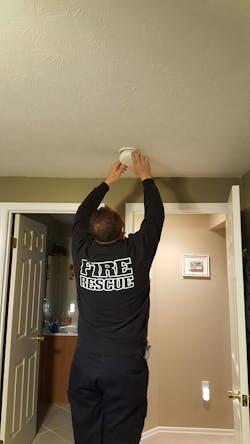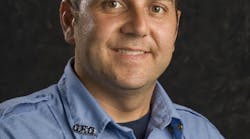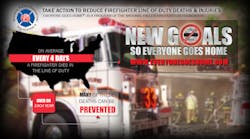Having a house fire can be an extremely traumatic experience for a person as they watch their home and valuables go up in smoke. They may have lost everything. They could be asking themselves what they could have done differently. How did it start and could it have been prevented? The fire department may be asking if the smoke alarms were working and if they were even heard when they first arrived. Many of the neighbors were outside watching the events unfold with panicked looks on their faces. Now that the fire is out, there are many questions to be answered. Clearly, the homeowner is most important at this point; however, what must the neighbors be thinking and questioning if this could happen to them?
Recently here in the Gates, NY, Fire District, we had a very similar situation take place. When the first engine pulled up there was heavy smoke and fire showing from a two-story wood-frame residential dwelling. Initial reports were that everyone was out. As we operated at the fire, the crowds grew. There was a look of concern on the faces throughout the crowd. Many times after a fire, neighbors have questions. Although we cannot get into specifics, we do want to put their minds at ease.
Addressing worries and concerns
After dealing with this issue for so many years, we came up with a policy. It is simple; have our crews back out on the street where the fire was within 24 hours to address neighbors’ concerns and to bring some awareness to fire safety. We need to put their minds at ease, educate the public, and make sure everyone has a working smoke alarm. The result is to help prevent fires, injuries, and fatalities as well as to reach out to the public to address their concerns. It is a win/win for everyone.
As the fire prevention officer for the district, the responsibility was mine to coordinate this outreach program. I never want this to be an all-night affair, but we need to get our crews out there for a reasonable amount of time. Having enough firefighters is a key element, and we are very fortunate in Gates to have a combination department as we are able to utilize volunteer and career firefighters. It works out great when you have plenty of manpower to get the job done.
We only need a few things to get this task accomplished. It’s important to have a game plan prior to heading out. Once the crew is together, everyone must be on the same page with what will be said. We have found it a good idea to have a short script for everyone so they know what should be said and most importantly what not to say. I have listed a few items below of what we discuss to educate the occupants that are simple and right to the point.
- We inform occupants of the best install locations throughout the home
- We ask them to test their smoke alarms monthly
- We remind them to replace smoke alarms every 10 years
- We ask them to discuss and practice an escape plan which includes having one location out front where the entire family should meet
- Most importantly, if they suspect a fire, to immediately get out and not attempt to extinguish it
We also bring along smoke alarms ready to be installed. We purchase them with donated funds we receive each year. We make sure we have some tools and a step ladder for easy and quick installs in the residences. We bring along a brochure to leave behind for the family to review. This is a simple document used to continue to educate the family after we have left. Prior to leaving, we make sure residents have our contact information if they should need to call us with any further questions. Generally, it is printed on the back side of our handout.
Choosing which homes to visit
So you’re probably wondering how we determine which houses to target and how many. In our department, we target about a dozen houses on each side of the street surrounding the fire. Sometimes it could be more, but there needs to be a cut off. How you do it is completely left up to you. We have found that word of mouth spreads quickly, so at times we have had to return to a neighbor’s home that we weren’t able to reach, and we are glad to do it. The more smoke alarms we can install, the safer our community will remain. According to the U.S. Fire Administration, fire deaths are cut in half when homes have a working smoke alarm.
Upon arrival, we split up the manpower so we aren’t all going to the same house. It is recommended to have three firefighters per house or it gets too congested. Typically, we spend about two hours canvassing the neighborhood. One thing to remember is that not everyone wants your help. If that is the case, just thank them for their time and move on.
What about the people who do want your help? Well, that’s easy. First, it’s important to introduce yourselves and that all are in uniform. A picture ID is always helpful as well if your department issues one. Briefly explain why you are there and what happened in their neighborhood the night before without giving any specific information that has not been publicly released. A simple introduction would be to introduce yourself with your name and the name of your fire department. Explain that there was a house fire in their neighborhood last night and that the neighbors are being canvassed to bring some awareness to fire safety. It is likely they already know, and they may have some questions. It’s okay to have dialogue, but be sure to keep it very general. Most people are very willing and thankful to let you in and help them especially when there is no charge for the service.
Next you should find out if there are working smoke alarms in the house. Residents may or may not know if their smoke alarm is working. This is when we ask to test them and possibly replace them. We install smoke alarms using a 10-year lithium ion battery, and we make sure that although they don’t have to change batteries they should at least be testing them monthly. If the alarm is not expired, we just swap out a battery for them. We install up to two smoke alarms if needed. We always install in the hallway where the bedrooms are located and on the first floor or basement. We also carry carbon monoxide alarms. If needed, we will install one unit as well.
During the install, a member of our crew will have the homeowner answer some questions and sign a liability waiver. The questions allow us to track installs, occupants with special needs, homes with working smoke alarms as well as some other items for statistical purposes. We use this information to better serve our community during an emergency. An install should take no longer than 15 minutes. We leave behind the smoke alarm brochure with our contact information, which they can further review. This program is available to any homeowner who lives in our fire district. All they need to do is call and schedule an appointment. In 2015, we installed 128 smoke alarms.
- Download: Liability Waiver & Data Collection Sheet
It may seem like a lot of work, but once you have your plan together, it is quite easy. This is a great way to connect with your community. It shows that the fire department cares about its residents, wants to educate them and is compassionate. This program is a great public relations tool and demonstrates our commitment to give back. Always remember that education, prevention and protection are the building blocks to a safer community!
JOSEPH MANUSE has been the career fire prevention officer for the Gates, NY, Fire District since 2008. He has been a volunteer firefighter with the Gates-Chili Fire Department for almost 28 years, holding the ranks of lieutenant, captain and assistant chief. As the fire prevention officer, he is responsible for providing various fire prevention and fire safety lessons through community outreach programs within the Gates-Chili School District, local businesses and senior centers. Manuse regularly conducts fire extinguisher/fire safety programs with many of our local businesses, assists with fire evacuation drills, and conducts a Junior Fire Academy every summer for middle school students. Manuse regularly attends training classes at the New York State Fire Academy and the National Fire Academy to maintain his certifications. In addition to his regular job responsibilities, he has obtained certifications as a Building Safety Inspector, Fire Instructor I and Fire Instructor II and is currently enrolled and working toward a fire protection associates degree.










